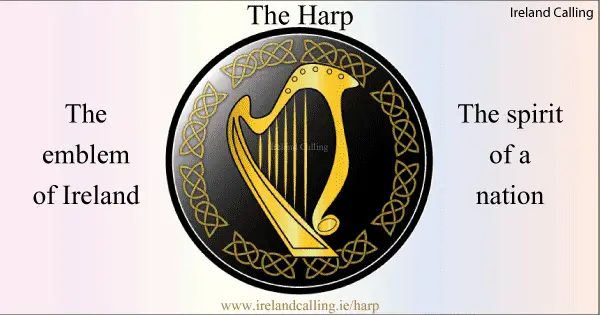While the shamrock is probably the most widely recognised symbol of Ireland, it’s the harp that has the accolade of being the official emblem.
Over the centuries, it’s come to reach across all areas of Irish life, from passports to Ryanair’s tail fin to bottles of Guinness.

It’s an understandable choice. Harp music has been a major part of Irish culture for at least a thousand years. No royal court or wealthy home was complete without a resident harpist in the Middle Ages.
The skill of these harpists was widely acclaimed across Europe. Gerald of Wales found little to impress him while visiting Ireland in the 12th century, except for the harp playing: “The only thing to which I find that this people apply a commendable industry is playing upon musical instruments, in which they are incomparably more skilful than any other nation I have ever seen.”
High praise indeed. The noble harp had many admirers in high places. The great High King, Brian Boru, was said to be an accomplished player.
There is no evidence for this, however, and it was quite common for the rich and powerful to be accredited with skills and qualities they didn’t really possess…a bit like Henry the VIII of England being accredited for composing the haunting melody Greensleeves. Again, no evidence and highly unlikely.
What is more certain about Henry is that he was the first person to adopt the harp as the official emblem of Ireland. In 1531, he declared himself King of Ireland as well as England.
He liked Irish harp music so much he adopted it as the official symbol of Ireland, even stamping it on Irish coins.
However, a proclamation from a foreign king would probably not of itself been enough to sustain it as a national emblem. In fact, with the rebellious Irish the harp’s adoption by an English king could have worked against it.
Instead, it went the other way. It remained the most popular instrument among Irish musicians long before the fiddle and the whistles came to prominence. Harpists like Turlough O’Carolan produced some of the best Irish music ever written and it is still popular today.
Indeed, The Chieftains have almost made a career out of playing the music of O’Carolan and other great Irish harpists.
In this way, harp music became a symbol of Irish identity, but that’s a dangerous quality in a country where the English rulers were trying to impose English laws, culture and identity.
At various times the English banned harp music along with other Irish icons like the shamrock and the colour green.
In 1603, Queen Elizabeth ordered her officials in Ireland “to hang the harpers, wherever found, and destroy their instruments.”
This attempt to stamp out Irish culture was mocked in songs like The Wearing of the Green, which were performed as an act of defiance in the 19th century.
Although the harp gave way to the fiddle, the flute and tin whistle as Ireland’s most widely played instruments, it retained its role as a symbol of Irish identity despite, or possibly because of, the attempts by the English to suppress it.
What better way to assert your identity than by adopting an emblem your oppressor tried ban?
The role of harp as the official Irish emblem was completed when the newly formed Free State government started using it on official documents, even placing it on the Presidential Seal. It still retains pride of place today.
More popular articles and videos
The real life mystery of what Maureen O’Hara whispered to make John Wayne look so shocked
Matt Damon winning hearts and minds with charm assault on Ireland
Action hero Tom Cruise was once attacked by an old man in a Kerry pub
Liam Neeson speaks about his late wife in emotional interview
Dating site explains why Irish men make wonderful husband material
Billy Connolly says public should ignore politicians and listen to comedians
Take a look inside Hollywood star Saoirse Ronan’s stunning Irish home
